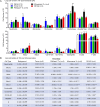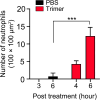Murine alveolar macrophages rapidly accumulate intranasally administered SARS-CoV-2 Spike protein leading to neutrophil recruitment and damage
- PMID: 38507462
- PMCID: PMC10954308
- DOI: 10.7554/eLife.86764
Murine alveolar macrophages rapidly accumulate intranasally administered SARS-CoV-2 Spike protein leading to neutrophil recruitment and damage
Abstract
The trimeric SARS-CoV-2 Spike protein mediates viral attachment facilitating cell entry. Most COVID-19 vaccines direct mammalian cells to express the Spike protein or deliver it directly via inoculation to engender a protective immune response. The trafficking and cellular tropism of the Spike protein in vivo and its impact on immune cells remains incompletely elucidated. In this study, we inoculated mice intranasally, intravenously, and subcutaneously with fluorescently labeled recombinant SARS-CoV-2 Spike protein. Using flow cytometry and imaging techniques, we analyzed its localization, immune cell tropism, and acute functional impact. Intranasal administration led to rapid lung alveolar macrophage uptake, pulmonary vascular leakage, and neutrophil recruitment and damage. When injected near the inguinal lymph node medullary, but not subcapsular macrophages, captured the protein, while scrotal injection recruited and fragmented neutrophils. Widespread endothelial and liver Kupffer cell uptake followed intravenous administration. Human peripheral blood cells B cells, neutrophils, monocytes, and myeloid dendritic cells all efficiently bound Spike protein. Exposure to the Spike protein enhanced neutrophil NETosis and augmented human macrophage TNF-α (tumor necrosis factor-α) and IL-6 production. Human and murine immune cells employed C-type lectin receptors and Siglecs to help capture the Spike protein. This study highlights the potential toxicity of the SARS-CoV-2 Spike protein for mammalian cells and illustrates the central role for alveolar macrophage in pathogenic protein uptake.
Keywords: NETosis; SARS-CoV-2; Siglec; Spike protein; alveolar macrophage; immunology; inflammation; mouse; neutrophil; pbmc; viral vector.
Conflict of interest statement
CP, IH, SY, SV, DW, DV, AG, CC, JA, JK No competing interests declared
Figures


















Update of
-
Murine Alveolar Macrophages Rapidly Accumulate Intranasally Administered SARS-CoV-2 Spike Protein leading to Neutrophil Recruitment and Damage.bioRxiv [Preprint]. 2023 Dec 4:2023.03.13.532446. doi: 10.1101/2023.03.13.532446. bioRxiv. 2023. Update in: Elife. 2024 Mar 20;12:RP86764. doi: 10.7554/eLife.86764. PMID: 37090605 Free PMC article. Updated. Preprint.
Similar articles
-
Murine Alveolar Macrophages Rapidly Accumulate Intranasally Administered SARS-CoV-2 Spike Protein leading to Neutrophil Recruitment and Damage.bioRxiv [Preprint]. 2023 Dec 4:2023.03.13.532446. doi: 10.1101/2023.03.13.532446. bioRxiv. 2023. Update in: Elife. 2024 Mar 20;12:RP86764. doi: 10.7554/eLife.86764. PMID: 37090605 Free PMC article. Updated. Preprint.
-
SARS-CoV-2 deregulates the vascular and immune functions of brain pericytes via Spike protein.Neurobiol Dis. 2021 Dec;161:105561. doi: 10.1016/j.nbd.2021.105561. Epub 2021 Nov 13. Neurobiol Dis. 2021. PMID: 34780863 Free PMC article.
-
An Intranasal OMV-Based Vaccine Induces High Mucosal and Systemic Protecting Immunity Against a SARS-CoV-2 Infection.Front Immunol. 2021 Dec 17;12:781280. doi: 10.3389/fimmu.2021.781280. eCollection 2021. Front Immunol. 2021. PMID: 34987509 Free PMC article.
-
Sialylated Glycan Bindings from SARS-CoV-2 Spike Protein to Blood and Endothelial Cells Govern the Severe Morbidities of COVID-19.Int J Mol Sci. 2023 Dec 1;24(23):17039. doi: 10.3390/ijms242317039. Int J Mol Sci. 2023. PMID: 38069362 Free PMC article. Review.
-
SARS-CoV-2 pandemic and research gaps: Understanding SARS-CoV-2 interaction with the ACE2 receptor and implications for therapy.Theranostics. 2020 Jun 12;10(16):7448-7464. doi: 10.7150/thno.48076. eCollection 2020. Theranostics. 2020. PMID: 32642005 Free PMC article. Review.
Cited by
-
The Ways of the Virus: Interactions of Platelets and Red Blood Cells with SARS-CoV-2, and Their Potential Pathophysiological Significance in COVID-19.Int J Mol Sci. 2023 Dec 9;24(24):17291. doi: 10.3390/ijms242417291. Int J Mol Sci. 2023. PMID: 38139118 Free PMC article. Review.
References
-
- Aizawa H, Zimmermann N, Carrigan PE, Lee JJ, Rothenberg ME, Bochner BS. Molecular analysis of human Siglec-8 orthologs relevant to mouse eosinophils: identification of mouse orthologs of Siglec-5 (mSiglec-F) and Siglec-10 (mSiglec-G) Genomics. 2003;82:521–530. doi: 10.1016/s0888-7543(03)00171-x. - DOI - PubMed
MeSH terms
Substances
LinkOut - more resources
Full Text Sources
Medical
Molecular Biology Databases
Research Materials
Miscellaneous

